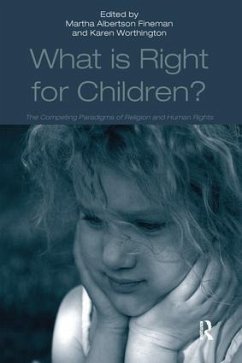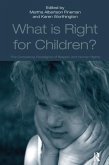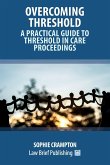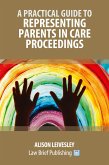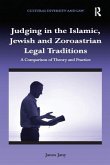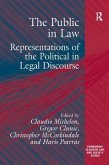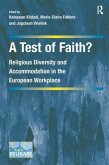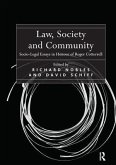Karen WorthingtonThe Competing Paradigms of Religion and Human Rights
What Is Right for Children?
The Competing Paradigms of Religion and Human Rights
Herausgeber: Fineman, Martha Albertson
Karen WorthingtonThe Competing Paradigms of Religion and Human Rights
What Is Right for Children?
The Competing Paradigms of Religion and Human Rights
Herausgeber: Fineman, Martha Albertson
- Broschiertes Buch
- Merkliste
- Auf die Merkliste
- Bewerten Bewerten
- Teilen
- Produkt teilen
- Produkterinnerung
- Produkterinnerung
Using international human rights norms as a touchstone, examining the state of 'rights-talk' about children in the US, this collection explores the presence, participation and treatment of children, in many contexts of US society.
Andere Kunden interessierten sich auch für
![What Is Right for Children? What Is Right for Children?]() What Is Right for Children?228,99 €
What Is Right for Children?228,99 €![Overcoming Threshold - A Practical Guide to Threshold in Care Proceedings Overcoming Threshold - A Practical Guide to Threshold in Care Proceedings]() Sophie CramptonOvercoming Threshold - A Practical Guide to Threshold in Care Proceedings111,99 €
Sophie CramptonOvercoming Threshold - A Practical Guide to Threshold in Care Proceedings111,99 €![A Practical Guide to Representing Parents in Care Proceedings A Practical Guide to Representing Parents in Care Proceedings]() Alison LeivesleyA Practical Guide to Representing Parents in Care Proceedings99,99 €
Alison LeivesleyA Practical Guide to Representing Parents in Care Proceedings99,99 €![Judging in the Islamic, Jewish and Zoroastrian Legal Traditions Judging in the Islamic, Jewish and Zoroastrian Legal Traditions]() Janos JanyJudging in the Islamic, Jewish and Zoroastrian Legal Traditions79,99 €
Janos JanyJudging in the Islamic, Jewish and Zoroastrian Legal Traditions79,99 €![The Public in Law The Public in Law]() Gregor ClunieThe Public in Law216,99 €
Gregor ClunieThe Public in Law216,99 €![A Test of Faith? A Test of Faith?]() A Test of Faith?216,99 €
A Test of Faith?216,99 €![Law, Society and Community Law, Society and Community]() Richard NoblesLaw, Society and Community80,99 €
Richard NoblesLaw, Society and Community80,99 €-
-
-
Using international human rights norms as a touchstone, examining the state of 'rights-talk' about children in the US, this collection explores the presence, participation and treatment of children, in many contexts of US society.
Hinweis: Dieser Artikel kann nur an eine deutsche Lieferadresse ausgeliefert werden.
Hinweis: Dieser Artikel kann nur an eine deutsche Lieferadresse ausgeliefert werden.
Produktdetails
- Produktdetails
- Verlag: Routledge
- Seitenzahl: 464
- Erscheinungstermin: 9. September 2016
- Englisch
- Abmessung: 234mm x 156mm x 25mm
- Gewicht: 699g
- ISBN-13: 9781138251083
- ISBN-10: 1138251089
- Artikelnr.: 48094405
- Herstellerkennzeichnung
- Libri GmbH
- Europaallee 1
- 36244 Bad Hersfeld
- gpsr@libri.de
- Verlag: Routledge
- Seitenzahl: 464
- Erscheinungstermin: 9. September 2016
- Englisch
- Abmessung: 234mm x 156mm x 25mm
- Gewicht: 699g
- ISBN-13: 9781138251083
- ISBN-10: 1138251089
- Artikelnr.: 48094405
- Herstellerkennzeichnung
- Libri GmbH
- Europaallee 1
- 36244 Bad Hersfeld
- gpsr@libri.de
Martha Albertson Fineman is Robert W. Woodruff Professor of Law at Emory Law School. She is an internationally recognized law and society scholar and a leading authority on family law and feminist jurisprudence. She is founder and director of the Feminism and Legal Theory Project, which was inaugurated in 1984 at the University of Wisconsin at Madison. The Project has since followed Professor Fineman to Columbia and Cornell, where she also held tenured faculty appointments, including the first Chair in the country in Feminist Jurisprudence. In addition to directing the Feminism and Legal Theory Project, Professor Fineman has published extensively on issues relating to family law, and feminist jurisprudence. She has received awards for her writing and teaching and has served on several government study commissions. She teaches family law, feminist jurisprudence, law and sexuality, and seminars on reproductive issues and select topics in feminist legal theory. Fineman is also a board member of Veteran Feminists of America and serves on the Transforming Community Project, an initiative aimed at improving racial relations and education on race scholarship at Emory. Karen Worthington is the founding director of the Barton Child Law & Policy Clinic at Emory Law School, where she directs the Clinic; supervises faculty, fellows and students; and teaches child advocacy. She has spent her career specializing in children's law and policy development. In addition to directing the Clinic since 2000, Professor Worthington directed the Southern Juvenile Defender Center from 2001-2005 and serves as a senior fellow with the Center for Study of Law and Religion at Emory Law.
Contents: Introduction: what is right for children?, Martha Albertson
Fineman; Part I Children's Rights as Human Rights: The United Nations
Convention on the Rights of the Child: empowering parents to protect their
children's rights, Barbara Bennett Woodhouse and Kathryn A. Johnson; Child,
family, state and gender equality in religious stances and human rights
instruments: a preliminary comparison, Linda C. McClain; Rhetoric, religion
and human rights: 'save the children!', Barbara Stark; Feminist
fundamentalism on the frontier between government and family responsibility
for children, Mary Ann Case. Part II Children in the United States: the
Legal Context: Using international human rights law in US courts: lessons
from the campaign against the juvenile death penalty, Linda M. Keller; The
lesser culpability of the juvenile offender: trial in adult criminal court,
incarceration with adults, and excessive sanctions, Bernadine Dohrn;
Parental rights doctrine: creating and maintaining maternal value, Annette
R. Appell; Placing children in context: parents, foster care, and poverty,
Naomi Cahn; Expanding the parent-child-state triangle in public family law:
the role of private providers, Susan Vivian Mangold; Advocating for
children's rights in a lawless nation: articulating rights for foster
children, Barbara Bennett Woodhouse and Brooke Hardy; A proposal for
collaborative enforcement of a federal right to education, Kimberley
Jenkins Robinson; Taking children's interests seriously, Martha Albertson
Fineman. Part III Comparisons: Children Within the Context of Human Rights:
Introduction; The child's right to religious freedom in international law:
the search for meaning, Ursula Kilkelly; Clashing rights and welfare: a
return to a rights discourse in family law in the UK?, Shazia Choudhry;
Accommodating children's religious expression in public schools: a
comparative analysis of the veil and other symbols in Western democracies,
Catherine J. Ross; Children, education, and rights in a society divided by
religion: the perspectives of children and young people, Laura Lundy;
Children, international human rights, and the politics of belonging, Alice
Hearst; The right of children to be loved, S. Matthew Liao; Appendix;
Bibliography; Index.
Fineman; Part I Children's Rights as Human Rights: The United Nations
Convention on the Rights of the Child: empowering parents to protect their
children's rights, Barbara Bennett Woodhouse and Kathryn A. Johnson; Child,
family, state and gender equality in religious stances and human rights
instruments: a preliminary comparison, Linda C. McClain; Rhetoric, religion
and human rights: 'save the children!', Barbara Stark; Feminist
fundamentalism on the frontier between government and family responsibility
for children, Mary Ann Case. Part II Children in the United States: the
Legal Context: Using international human rights law in US courts: lessons
from the campaign against the juvenile death penalty, Linda M. Keller; The
lesser culpability of the juvenile offender: trial in adult criminal court,
incarceration with adults, and excessive sanctions, Bernadine Dohrn;
Parental rights doctrine: creating and maintaining maternal value, Annette
R. Appell; Placing children in context: parents, foster care, and poverty,
Naomi Cahn; Expanding the parent-child-state triangle in public family law:
the role of private providers, Susan Vivian Mangold; Advocating for
children's rights in a lawless nation: articulating rights for foster
children, Barbara Bennett Woodhouse and Brooke Hardy; A proposal for
collaborative enforcement of a federal right to education, Kimberley
Jenkins Robinson; Taking children's interests seriously, Martha Albertson
Fineman. Part III Comparisons: Children Within the Context of Human Rights:
Introduction; The child's right to religious freedom in international law:
the search for meaning, Ursula Kilkelly; Clashing rights and welfare: a
return to a rights discourse in family law in the UK?, Shazia Choudhry;
Accommodating children's religious expression in public schools: a
comparative analysis of the veil and other symbols in Western democracies,
Catherine J. Ross; Children, education, and rights in a society divided by
religion: the perspectives of children and young people, Laura Lundy;
Children, international human rights, and the politics of belonging, Alice
Hearst; The right of children to be loved, S. Matthew Liao; Appendix;
Bibliography; Index.
Contents: Introduction: what is right for children?, Martha Albertson
Fineman; Part I Children's Rights as Human Rights: The United Nations
Convention on the Rights of the Child: empowering parents to protect their
children's rights, Barbara Bennett Woodhouse and Kathryn A. Johnson; Child,
family, state and gender equality in religious stances and human rights
instruments: a preliminary comparison, Linda C. McClain; Rhetoric, religion
and human rights: 'save the children!', Barbara Stark; Feminist
fundamentalism on the frontier between government and family responsibility
for children, Mary Ann Case. Part II Children in the United States: the
Legal Context: Using international human rights law in US courts: lessons
from the campaign against the juvenile death penalty, Linda M. Keller; The
lesser culpability of the juvenile offender: trial in adult criminal court,
incarceration with adults, and excessive sanctions, Bernadine Dohrn;
Parental rights doctrine: creating and maintaining maternal value, Annette
R. Appell; Placing children in context: parents, foster care, and poverty,
Naomi Cahn; Expanding the parent-child-state triangle in public family law:
the role of private providers, Susan Vivian Mangold; Advocating for
children's rights in a lawless nation: articulating rights for foster
children, Barbara Bennett Woodhouse and Brooke Hardy; A proposal for
collaborative enforcement of a federal right to education, Kimberley
Jenkins Robinson; Taking children's interests seriously, Martha Albertson
Fineman. Part III Comparisons: Children Within the Context of Human Rights:
Introduction; The child's right to religious freedom in international law:
the search for meaning, Ursula Kilkelly; Clashing rights and welfare: a
return to a rights discourse in family law in the UK?, Shazia Choudhry;
Accommodating children's religious expression in public schools: a
comparative analysis of the veil and other symbols in Western democracies,
Catherine J. Ross; Children, education, and rights in a society divided by
religion: the perspectives of children and young people, Laura Lundy;
Children, international human rights, and the politics of belonging, Alice
Hearst; The right of children to be loved, S. Matthew Liao; Appendix;
Bibliography; Index.
Fineman; Part I Children's Rights as Human Rights: The United Nations
Convention on the Rights of the Child: empowering parents to protect their
children's rights, Barbara Bennett Woodhouse and Kathryn A. Johnson; Child,
family, state and gender equality in religious stances and human rights
instruments: a preliminary comparison, Linda C. McClain; Rhetoric, religion
and human rights: 'save the children!', Barbara Stark; Feminist
fundamentalism on the frontier between government and family responsibility
for children, Mary Ann Case. Part II Children in the United States: the
Legal Context: Using international human rights law in US courts: lessons
from the campaign against the juvenile death penalty, Linda M. Keller; The
lesser culpability of the juvenile offender: trial in adult criminal court,
incarceration with adults, and excessive sanctions, Bernadine Dohrn;
Parental rights doctrine: creating and maintaining maternal value, Annette
R. Appell; Placing children in context: parents, foster care, and poverty,
Naomi Cahn; Expanding the parent-child-state triangle in public family law:
the role of private providers, Susan Vivian Mangold; Advocating for
children's rights in a lawless nation: articulating rights for foster
children, Barbara Bennett Woodhouse and Brooke Hardy; A proposal for
collaborative enforcement of a federal right to education, Kimberley
Jenkins Robinson; Taking children's interests seriously, Martha Albertson
Fineman. Part III Comparisons: Children Within the Context of Human Rights:
Introduction; The child's right to religious freedom in international law:
the search for meaning, Ursula Kilkelly; Clashing rights and welfare: a
return to a rights discourse in family law in the UK?, Shazia Choudhry;
Accommodating children's religious expression in public schools: a
comparative analysis of the veil and other symbols in Western democracies,
Catherine J. Ross; Children, education, and rights in a society divided by
religion: the perspectives of children and young people, Laura Lundy;
Children, international human rights, and the politics of belonging, Alice
Hearst; The right of children to be loved, S. Matthew Liao; Appendix;
Bibliography; Index.

